中国全科医学 ›› 2024, Vol. 27 ›› Issue (05): 628-636.DOI: 10.12114/j.issn.1007-9572.2023.0357
• 论著·医学循证 • 上一篇
方仪德1, 胡浩1, 许金海1,2, 丁兴1, 马青山1, 张亚运1, 王燕妮1, 莫文1,2,*( )
)
收稿日期:2023-05-06
修回日期:2023-08-17
出版日期:2024-02-15
发布日期:2023-11-21
通讯作者:
莫文
基金资助:
FANG Yide1, HU Hao1, XU Jinhai1,2, DING Xing1, MA Qingshan1, ZHANG Yayun1, WANG Yanni1, MO Wen1,2,*( )
)
Received:2023-05-06
Revised:2023-08-17
Published:2024-02-15
Online:2023-11-21
Contact:
MO Wen
About author:摘要: 背景 近年出现较多特色手法治疗肩周炎的随机对照试验(RCT),但缺乏新的关于手法治疗肩周炎有效性和安全性的系统评价。 目的 通过Meta分析方法评价手法治疗肩周炎的有效性和安全性,通过亚组分析了解包含"摇法"的手法是否较未包含"摇法"的手法效果更优。 方法 计算机检索PubMed、Cochrane Library、Embase、Medline、中国知网(包括中国硕博士学位论文全文数据库、中国优秀硕士学位论文全文数据库)、中国生物医学文献数据库、万方数据知识服务平台中有关手法治疗肩周炎有效性和安全性的RCT,试验组干预措施为手法,对照组干预措施为非药物疗法,检索时间为建库至2023-03-01。由2名研究人员提取资料,并进行质量评价。采用Revman 5.3软件进行Meta分析。 结果 最终共纳入12篇文献,893例肩周炎患者,其中试验组451例,对照组442例。Meta分析结果显示,视觉模拟疼痛量表(VAS):手法治疗改善VAS程度优于物理治疗、针灸治疗、常规治疗(SMD=1.09,95%CI=0.81~1.37,P<0.000 01;SMD=1.05,95%CI=0.31~1.79,P=0.006;SMD=0.96,95%CI=0.67~1.26,P<0.000 01);手法对照物理治疗的亚组分析结果显示,含"摇法"手法与未含"摇法"手法的效果差异显著(Z=4.39,P=0.04)。Constant-Murley(C-M)评分:手法治疗改善C-M评分程度优于物理治疗组(MD=2.79,95%CI=2.27~3.32,P<0.000 01)。关节活动度:手法治疗改善被动前屈、被动外展、被动外旋程度优于物理治疗(SMD=1.40,95%CI=0.10~2.70,P=0.03;SMD=1.45,95%CI=0.18~2.71,P=0.02;SMD=1.77,95%CI=0.18~3.36,P=0.03)。亚组分析结果显示,在改善被动前屈和被动外展方面,含"摇法"手法与未含"摇法"手法的效果存在显著差异(Z=7.34,P=0.007;Z=2.25,P=0.03)。总体有效率:手法治疗总体有效率高于物理治疗(RR=1.16,95%CI=1.02~1.32,P=0.03);手法治疗和针灸治疗总体有效率比较,差异无统计学意义(RR=1.24,95%CI=1.00~1.54,P=0.05)。治愈率:手法治疗治愈率优于物理治疗和针灸治疗(RR=3.71,95%CI=1.29~10.67,P=0.01;RR=1.79,95%CI=1.09~2.94,P=0.02)。Egger's检验和Begger's检验提示无显著的发表偏倚(P=0.66、0.66)。手法操作导致的骨折、其他创伤等案例在纳入研究中均未见报道。 结论 现有文献证据表明手法治疗能有效降低肩周炎患者疼痛、肩关节功能障碍,提高患者肩关节活动度、总体有效率、治愈率,含有"摇法"的手法在VAS改善、被动前屈、被动外展方面能进一步提高疗效,总体手法安全性较高,但仍需更多大样本,高质量的RCT进一步证实。
| 第一作者 | 发表时间(年) | 地区 | 样本量(T/C) | 干预措施(T/C) | 摇法 | 疗程 | 结局指标 |
|---|---|---|---|---|---|---|---|
| 雷培政[ | 2013 | 中国 | 60/60 | 手法/针灸 | 无 | 56 d,4次/d | VAS、总体有效率、肩关节功能评分 |
| 郭张海[ | 2019 | 中国 | 58/57 | 手法/针灸 | 有 | 30 d,隔日1次 | VAS、总体有效率 |
| 李忠龙[ | 2016 | 中国 | 30/30 | 手法/针灸 | 有 | 3周,1次/d | VAS、总体有效率 |
| ZHANG[ | 2016 | 中国 | 38/38 | 手法/针灸 | 有 | 10 d,1次/d | VAS、总体有效率、肩部功能评分 |
| 王建民[ | 2022 | 中国 | 29/28 | 手法/物理治疗 | 有 | 6周,3次/周 | VAS、总体有效率、C-M评分 |
| 叶斌[ | 2014 | 中国 | 35/35 | 手法/物理治疗 | 有 | 2周,3次/周 | VAS、肩关节功能评分 |
| 刘辉辉[ | 2013 | 中国 | 30/30 | 手法/物理治疗 | 有 | 20 d,1次/d | 疼痛评分、总体有效率、肩关节功能指数 |
| 郑朱喜[ | 2007 | 中国 | 35/35 | 手法/物理治疗 | 无 | 28 d,1次/d | VAS、总体有效率、肩关节功能评分 |
| SRIVASTAVA[ | 2021 | 印度 | 17/17 | 手法/物理治疗 | 有 | 2周,3次/周 | VAS、SPADI、肩关节角度 |
| GUTIÉRREZ ESPINOZA[ | 2015 | 智利 | 29/28 | 手法/物理治疗 | 有 | 10次,2~3次/周 | VAS、C-M评分、肩关节角度 |
| GULER-UYSAL[ | 2004 | 土耳其 | 19/13 | 手法/物理治疗 | 无 | 2周,3次/周 | VAS、肩关节角度 |
| 徐玉德[ | 2015 | 中国 | 60/60 | 手法/关节腔注射 | 有 | 3周,1次/d | VAS、总体有效率、肩部角度、C-M评分 |
表1 纳入文献的基本特征
Table 1 Basic characteristics of the included literature
| 第一作者 | 发表时间(年) | 地区 | 样本量(T/C) | 干预措施(T/C) | 摇法 | 疗程 | 结局指标 |
|---|---|---|---|---|---|---|---|
| 雷培政[ | 2013 | 中国 | 60/60 | 手法/针灸 | 无 | 56 d,4次/d | VAS、总体有效率、肩关节功能评分 |
| 郭张海[ | 2019 | 中国 | 58/57 | 手法/针灸 | 有 | 30 d,隔日1次 | VAS、总体有效率 |
| 李忠龙[ | 2016 | 中国 | 30/30 | 手法/针灸 | 有 | 3周,1次/d | VAS、总体有效率 |
| ZHANG[ | 2016 | 中国 | 38/38 | 手法/针灸 | 有 | 10 d,1次/d | VAS、总体有效率、肩部功能评分 |
| 王建民[ | 2022 | 中国 | 29/28 | 手法/物理治疗 | 有 | 6周,3次/周 | VAS、总体有效率、C-M评分 |
| 叶斌[ | 2014 | 中国 | 35/35 | 手法/物理治疗 | 有 | 2周,3次/周 | VAS、肩关节功能评分 |
| 刘辉辉[ | 2013 | 中国 | 30/30 | 手法/物理治疗 | 有 | 20 d,1次/d | 疼痛评分、总体有效率、肩关节功能指数 |
| 郑朱喜[ | 2007 | 中国 | 35/35 | 手法/物理治疗 | 无 | 28 d,1次/d | VAS、总体有效率、肩关节功能评分 |
| SRIVASTAVA[ | 2021 | 印度 | 17/17 | 手法/物理治疗 | 有 | 2周,3次/周 | VAS、SPADI、肩关节角度 |
| GUTIÉRREZ ESPINOZA[ | 2015 | 智利 | 29/28 | 手法/物理治疗 | 有 | 10次,2~3次/周 | VAS、C-M评分、肩关节角度 |
| GULER-UYSAL[ | 2004 | 土耳其 | 19/13 | 手法/物理治疗 | 无 | 2周,3次/周 | VAS、肩关节角度 |
| 徐玉德[ | 2015 | 中国 | 60/60 | 手法/关节腔注射 | 有 | 3周,1次/d | VAS、总体有效率、肩部角度、C-M评分 |
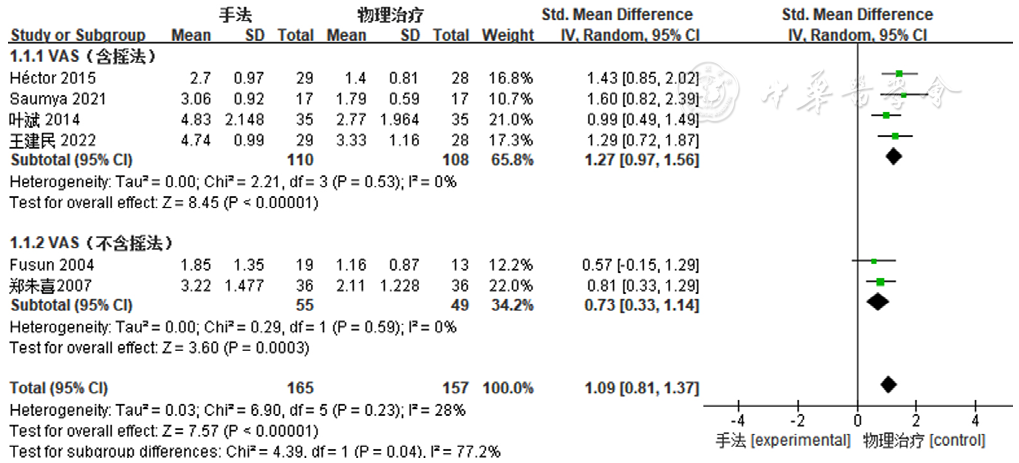
图4 手法对照物理治疗后肩周炎患者VAS比较的森林图
Figure 4 Forest plot comparing VAS in patients with frozen shoulder after manipulative therapy compared to physical therapy
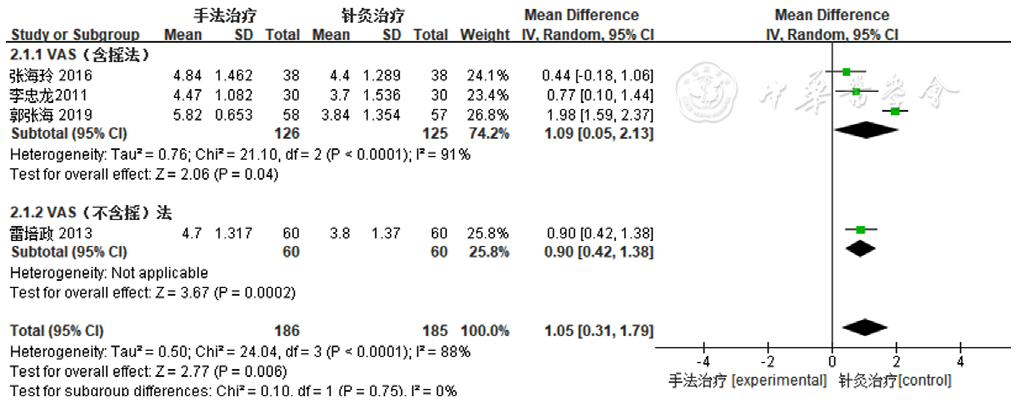
图5 手法对照针灸治疗后肩周炎患者VAS比较的森林图
Figure 5 Forest plot comparing VAS in patients with frozen shoulder after manipulative therapy compared to acupuncture therapy
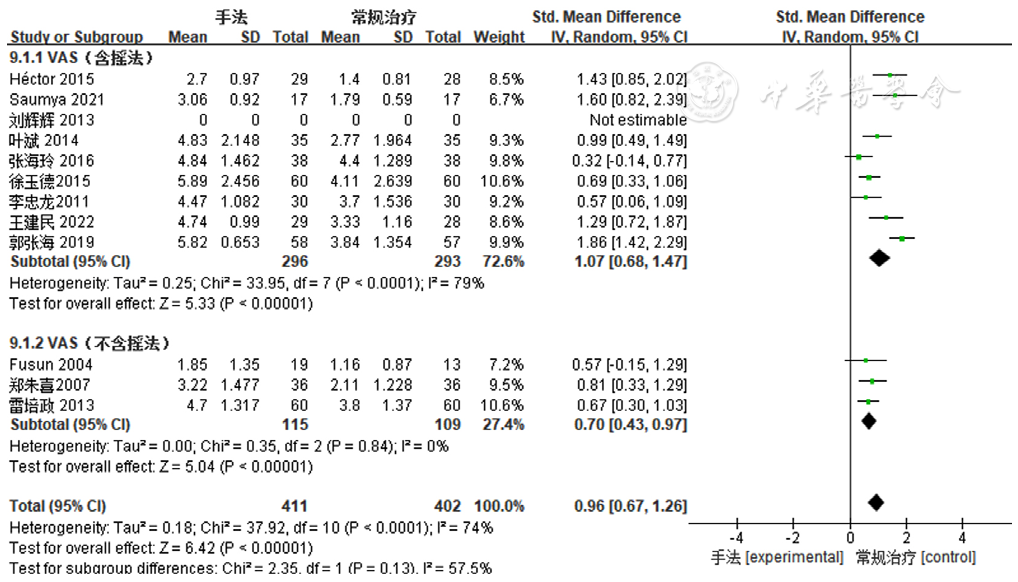
图6 手法对照常规治疗后肩周炎患者VAS比较的森林图
Figure 6 Forest plot comparing VAS in patients with frozen shoulder after manipulative therapy compared to conventional therapy

图7 手法对照物理治疗后肩周炎患者C-M评分比较的森林图
Figure 7 Forest plot comparing C-M scores in patients with frozen shoulder after manipulative therapy compared to physical therapy
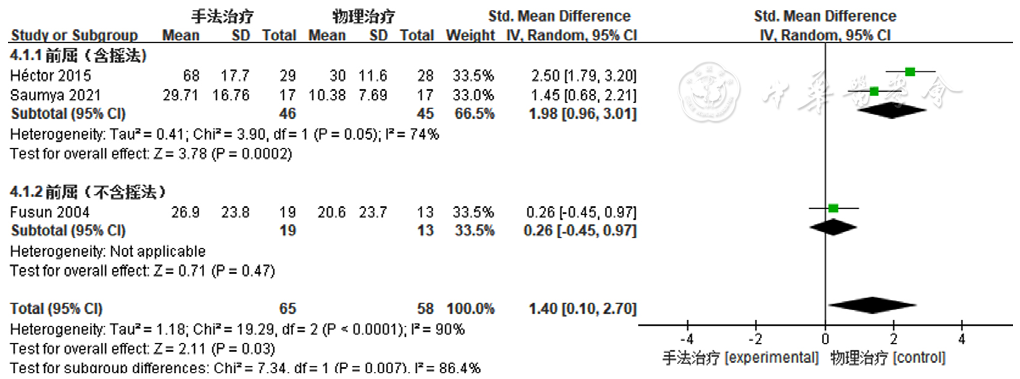
图8 手法对照物理治疗后肩周炎患者被动前屈活动度改善比较的森林图
Figure 8 Forest plot comparing improvement of passive forward flexion in patients with frozen shoulder after manipulative therapy compared to physical therapy
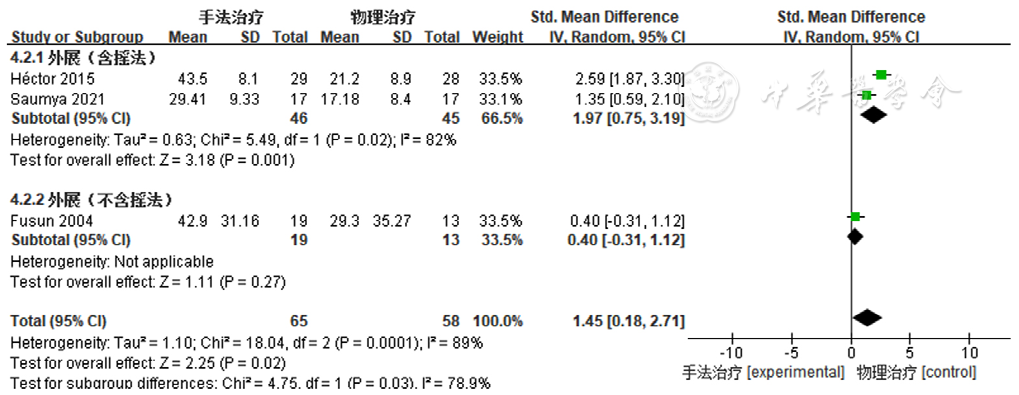
图9 手法对照物理治疗后肩周炎患者被动外展活动度改善比较的森林图
Figure 9 Forest plot comparing improvement of passive abduction in patients with frozen shoulder after manipulative therapy compared to physical therapy
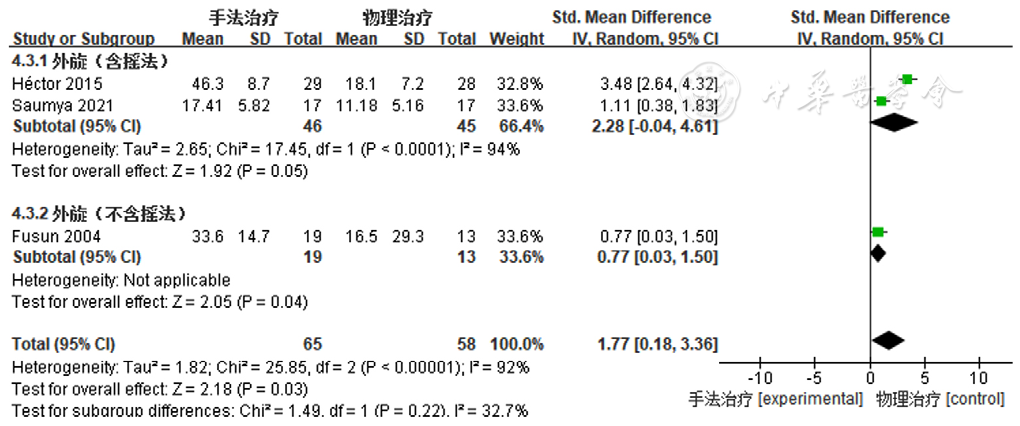
图10 手法对照物理治疗后肩周炎患者被动外旋活动度改善比较的森林图
Figure 10 Forest plot comparing improvement of passive external rotation in patients with frozen shoulder after manipulative therapy compared to physical therapy
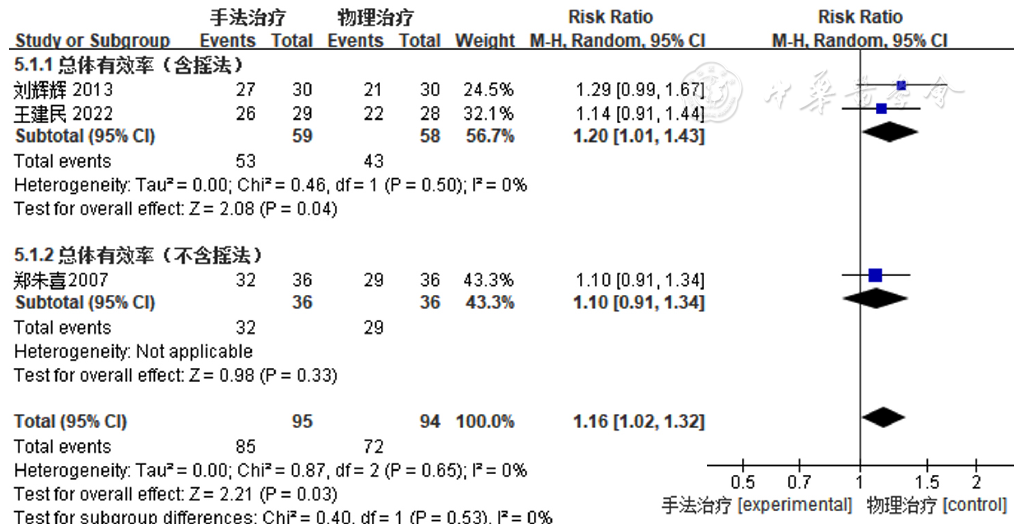
图11 手法对照物理治疗后肩周炎患者总体有效率比较的森林图
Figure 11 Forest plot comparing overall effective rate in patients with frozen shoulder after manipulative therapy compared to physical therapy
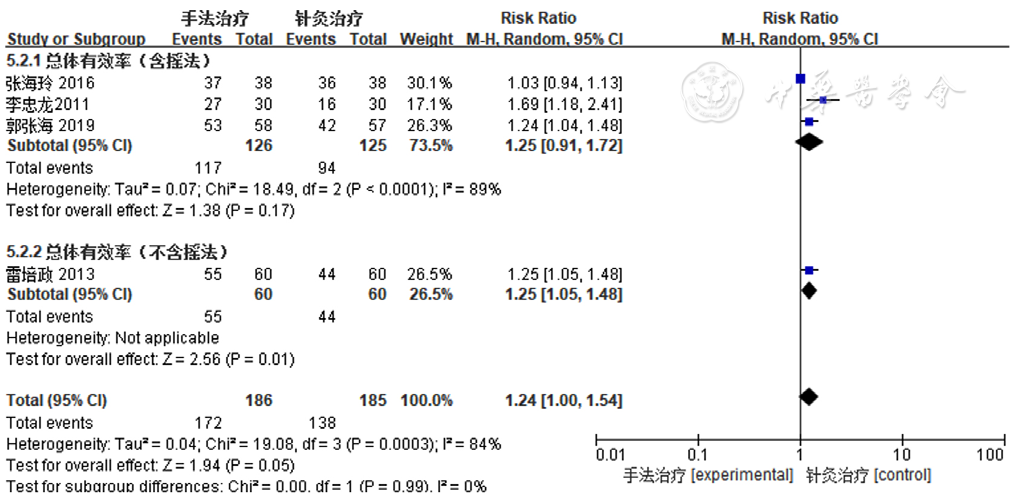
图12 手法对照针灸治疗后肩周炎患者总体有效率比较的森林图
Figure 12 Forest plot comparing overall effective rate of patients with frozen shoulder after manipulative therapy compared to acupuncture therapy
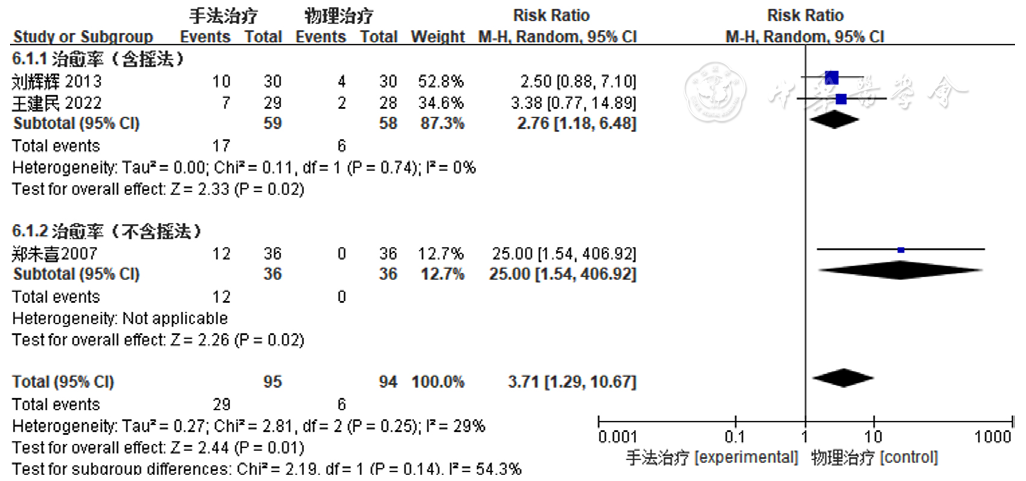
图13 手法对照物理治疗后肩周炎患者治愈率比较的森林图
Figure 13 Forest plot comparing cure rate of patients with frozen shoulder after manipulative therapy compared to physical therapy
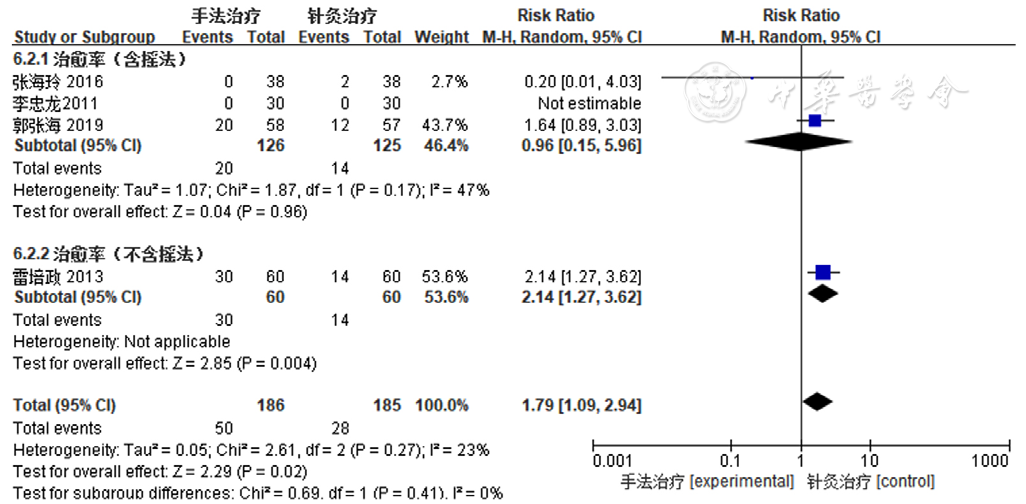
图14 手法对照针灸治疗后肩周炎患者治愈率比较的森林图
Figure 14 Forest plot comparing cure rate of patients with frozen shoulder after manipulative therapy compared to acupuncture therapy
| [1] |
|
| [2] |
|
| [3] |
|
| [4] |
|
| [5] |
中华中医药学会骨伤科分会. 中医骨伤科临床诊疗指南·肩关节周围炎:T/CACM 1179—2019[J]. 上海中医药杂志,2022,56(3):1-5. DOI:10.16305/j.1007-1334.2022.2112084.
|
| [6] |
国家中医药管理局. 中医病证诊断疗效标准:ZY/T001.1-001.9-94[M]. 南京:南京大学出版社,1994:78.
|
| [7] |
|
| [8] |
李幼平,杨晓妍,李鸿浩. 知证卫生决策工具附件——评估设计(改编自Cochrane干预措施系统评价手册)(文18附件2)[J]. 中国循证医学杂志,2010,10(6):647.
|
| [9] |
雷培政. 推拿治疗肩关节周围炎随机平行对照研究[J]. 实用中医内科杂志,2013,27(13):157-159. DOI:10.3969/j.issn.1671-7813.2013.07(s).78.
|
| [10] |
郭张海,孙义玲,王卫强. "五步一摇法"治疗肩周炎的临床观察[J]. 中国民间疗法,2019,27(3):25-26. DOI:10.19621/j.cnki.11-3555/r.2019.0313.
|
| [11] |
李忠龙,梁军. 推拿治疗肩关节周围炎的随机对照临床研究[J]. 中华中医药杂志,2011,26(12):3014-3016.
|
| [12] |
|
| [13] |
王建民. 三步推拿法干预冻结肩关节囊纤维化的临床及实验研究[D]. 济南:山东中医药大学,2022.
|
| [14] | |
| [15] |
刘辉辉. 循经弹拨法治疗肩关节周围炎的临床研究[D]. 长春:长春中医药大学,2013.
|
| [16] |
郑朱喜,董福慧. 理疗床和手法治疗肩关节周围炎的随机对照临床观察[J]. 中国骨伤,2007,20(S1):32-33.
|
| [17] |
|
| [18] |
|
| [19] |
|
| [20] |
徐玉德,谢兴文,董林,等. 四步按摩法治疗肩周炎60例[J]. 西部中医药,2015,28(8):130-132.
|
| [21] |
石修权,王增珍. Egger's test与Begg's test的功效差异比较与原因分析[J]. 华中科技大学学报(医学版),2009,38(1):91-93; 91-93,102. DOI:10.3870/j.issn.1672-0741.2009.01.023.
|
| [22] |
王丽娟,张海英,罗和平,等. 圆利针伞形刺并温针治疗风寒湿证肩周炎的随机对照研究[J]. 针灸临床杂志,2021,37(1):35-39. DOI:10.19917/j.cnki.1005-0779.021010.
|
| [23] |
夏秀梅,舒锦尔,赵小忠,等. 盂肱下韧带MR影像对冻结肩的诊断价值[J]. 医学影像学杂志,2019,29(3):481-484.
|
| [24] |
|
| [25] |
石宝营,苏艳美. 痛点针刀松解结合肩关节回转手法治疗肩关节周围炎85例[J]. 中国中医骨伤科杂志,2013,21(8):50-51.
|
| [26] | |
| [27] |
周海旺. 阳性点持续移位手法治疗粘连期肩周炎的临床观察[J]. 浙江中医药大学学报,2013,37(2):193-194. DOI:10.16466/j.issn1005-5509.2013.02.017.
|
| [28] | |
| [29] |
杨晓伟,盛锋,徐枫,等. 脊柱微调手法治疗肩关节周围炎临床观察[J]. 上海中医药大学学报,2019,33(5):39-42. DOI:10.16306/j.1008-861x.2019.05.008.
|
| [30] |
赵明宇,赵启. 平乐正骨"筋滞骨错"理论探析[J]. 中医正骨,2014,26(8):68-70.
|
| [31] |
|
| [32] | |
| [33] |
陈柯村,施杞,朱穆朗玛,等. 旋转牵伸类手法治疗冻结肩的系统评价与Meta分析[J]. 上海中医药杂志,2019,53(8):15-21. DOI:10.16305/j.1007-1334.2019.08.004.
|
| [34] |
方仪德,许金海,叶洁,等. 国医大师施杞整肩三步九法治疗肩周炎的学术思想及临证经验[J]. 中国中医骨伤科杂志,2022,30(10):74-75; 74-75,79.
|
| [35] |
汤子寒. 太极推拿摇法治疗肩周炎的临床观察[D]. 武汉:湖北中医药大学,2021.
|
| [36] |
|
| [37] |
|
| [38] |
|
| [39] |
李迎春,梁英,杜一婷,等. 超声扫查肩后方关节囊厚度及盂肱距离对分期诊断冻结肩的价值[J]. 中国医学影像技术,2019,35(8):1147-1150. DOI:10.13929/j.1003-3289.201904006.
|
| [40] |
林丽蓉. 医学综合征大全[M]. 北京:中国科学技术出版社,1994.
|
| [1] | 许佳兰, 阎红, 文君, 周紫彤, 王思宇. 老年癌症患者潜在不适当用药发生率的Meta分析[J]. 中国全科医学, 2025, 28(30): 3815-3822. |
| [2] | 张天宇, 于海搏, 陈飞, 李新, 张佳佳, 詹晓凯, 申曼, 汤然, 范斯斌, 赵凤仪, 黄仲夏. POEMS综合征全身系统性治疗疗效和安全性的Meta分析[J]. 中国全科医学, 2025, 28(27): 3447-3455. |
| [3] | 全家霖, 朱琳, 苏煜, 陈泽恺, 陈梓淇, 张卓凡. 运动方式对超重或肥胖儿童青少年执行功能改善效果的网状Meta分析[J]. 中国全科医学, 2025, 28(27): 3422-3431. |
| [4] | 聂丹宁, 史曙生, 陶昱如. 本体感觉神经肌肉促进技术联合螺旋稳定肌肉链训练治疗青少年特发性脊柱侧弯的临床效果研究[J]. 中国全科医学, 2025, 28(24): 3032-3042. |
| [5] | 蒋世华, 朱政, 任盈盈, 朱垚磊, 王越, 高希彬. 中国儿童青少年近视患病率及影响因素的Meta分析[J]. 中国全科医学, 2025, 28(24): 3043-3052. |
| [6] | 李浩, 李江涛, 刘丹, 王建军. 贝利尤单抗和阿尼鲁单抗及泰它西普治疗系统性红斑狼疮疗效和安全性的网状Meta分析[J]. 中国全科医学, 2025, 28(23): 2924-2933. |
| [7] | 王笑林, 李秋月, 周彦君, 张金辉, 梁涛. 转移性结直肠癌患者呋喹替尼治疗相关心血管毒性发生率和风险的Meta分析[J]. 中国全科医学, 2025, 28(23): 2934-2940. |
| [8] | 文敏, 周永玲, 刘静静, 蒋苛晴, 刘娟, 朱晓丹. 基于移动医疗APP的认知补偿训练对稳定期精神分裂症患者的干预效果与机制研究[J]. 中国全科医学, 2025, 28(22): 2819-2825. |
| [9] | 杨涵单, 乔雯, 何姝, 陈易, 童云梅. 接纳承诺疗法联合舍曲林对抑郁症青少年抑郁情绪、自杀意念及睡眠质量的影响研究[J]. 中国全科医学, 2025, 28(22): 2813-2818. |
| [10] | 王颖, 颜轶隽, 刘蕾, 胡毓敏, 张扬, 刘凯, 姜博仁. 抗阻力运动联合营养干预对老年2型糖尿病合并肌少症患者血糖稳定性影响的临床研究[J]. 中国全科医学, 2025, 28(21): 2604-2610. |
| [11] | 马盼盼, 王思静, 游娜, 丁大法, 鲁一兵. Danuglipron与Orforglipron治疗2型糖尿病疗效及安全性的Meta分析[J]. 中国全科医学, 2025, 28(21): 2679-2685. |
| [12] | 胡婉琴, 余深艳, 曹学华, 向凤, 贾钰. 中国儿童性早熟影响因素的Meta分析[J]. 中国全科医学, 2025, 28(21): 2661-2671. |
| [13] | 阿迪力·吐尔孙, 程刚. 非奈利酮治疗2型糖尿病肾病有效性和安全性的Meta分析[J]. 中国全科医学, 2025, 28(21): 2686-2691. |
| [14] | 郭盛滕, 张芬芬, 万迪, 于冬梅, 王庆华. 重症急性胰腺炎并发急性肺损伤危险因素的Meta分析[J]. 中国全科医学, 2025, 28(20): 2546-2554. |
| [15] | 王碧晴, 张萍, 杨红霞, 王倩, 鞠春晓, 赵俊男, 梅俊, 张颖, 徐凤芹. 中国老年高血压患者轻度认知障碍患病率及发展趋势的Meta分析[J]. 中国全科医学, 2025, 28(17): 2186-2192. |
| 阅读次数 | ||||||
|
全文 |
|
|||||
|
摘要 |
|
|||||





